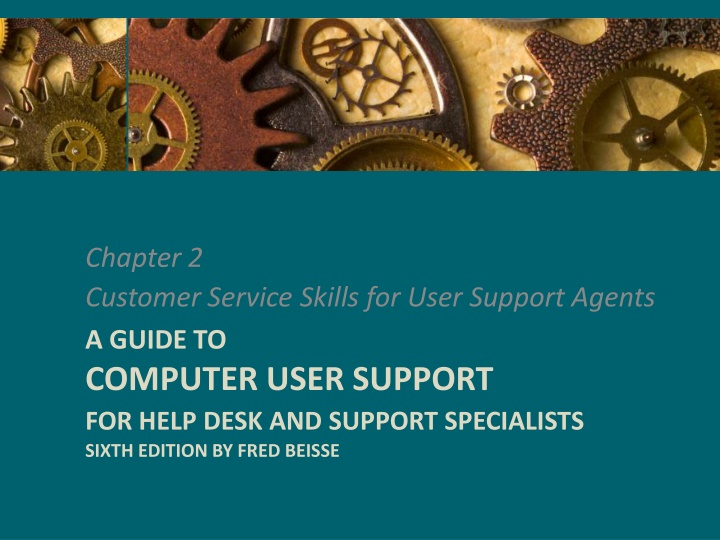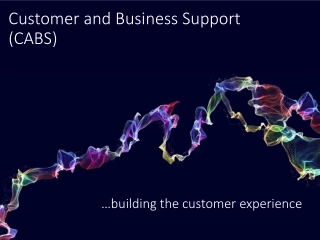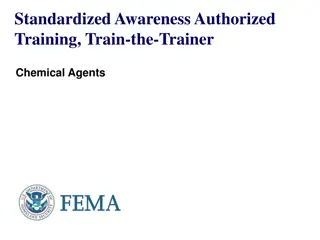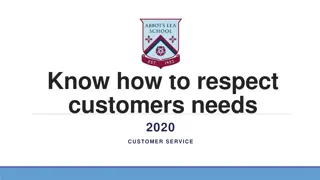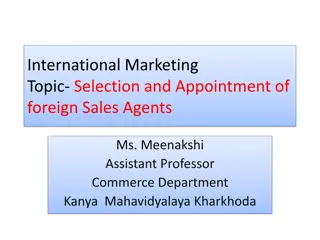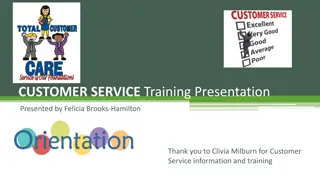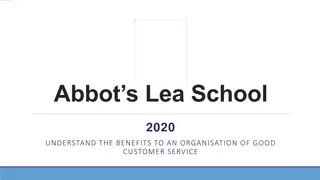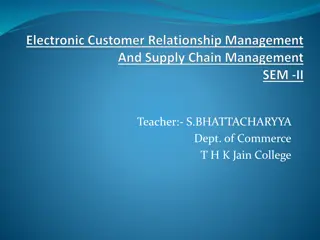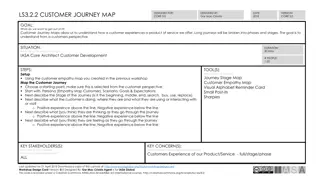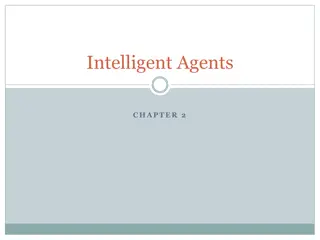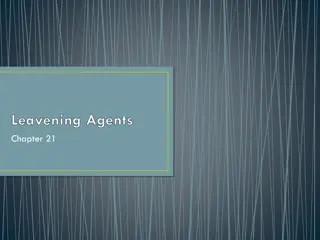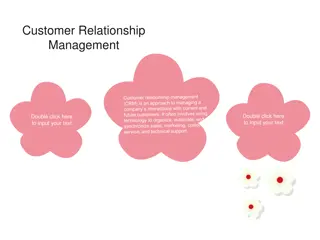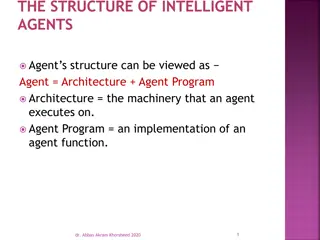Customer Service Skills for User Support Agents - A Guide to Computer User Support for Help Desk and Support Specialists
This guide provides essential skills for user support agents in the field of customer service. It covers topics such as effective communication, problem-solving, and technical know-how to assist users efficiently. The sixth edition by Fred Beisse offers practical insights and strategies for navigating help desk scenarios, ensuring a seamless support experience for both agents and users. Whether you are a seasoned support specialist or new to the field, this resource equips you with the tools to excel in user support roles.
Download Presentation

Please find below an Image/Link to download the presentation.
The content on the website is provided AS IS for your information and personal use only. It may not be sold, licensed, or shared on other websites without obtaining consent from the author.If you encounter any issues during the download, it is possible that the publisher has removed the file from their server.
You are allowed to download the files provided on this website for personal or commercial use, subject to the condition that they are used lawfully. All files are the property of their respective owners.
The content on the website is provided AS IS for your information and personal use only. It may not be sold, licensed, or shared on other websites without obtaining consent from the author.
E N D
Presentation Transcript
Chapter 2 Customer Service Skills for User Support Agents A GUIDE TO COMPUTER USER SUPPORT FOR HELP DESK AND SUPPORT SPECIALISTS SIXTH EDITION BY FRED BEISSE
Chapter Objectives The importance of strong relationships and good communication and interpersonal skills Reasons support agents must listen and read carefully, build and communicate understanding, and use verbal and nonverbal communication effectively How support agents develop a personal communication style How support agents develop an incident management strategy A Guide to Computer User Support for Help Desk and Support Specialists, Sixth Edition 2
Chapter Objectives (continued) Strategies support agents use for voice and web- based communications Strategies support agents use for working with difficult clients and incidents and for resolving conflicts How developing an understanding of different personality types and work styles can help an agent How to build excellent customer service A Guide to Computer User Support for Help Desk and Support Specialists, Sixth Edition 3
Communication and Interpersonal Skills Are Important to Learn Excellent communication and interpersonal skills are often more challenging for new support workers to learn than technical or business skills! A Guide to Computer User Support for Help Desk and Support Specialists, Sixth Edition 4
A Customer Service Ethic A customer-service ethic An organization-wide commitment Shared by everyone Client relationships and client satisfaction are the most important aspects of a business Goal: 100 percent client satisfaction 100 percent of the time A Guide to Computer User Support for Help Desk and Support Specialists, Sixth Edition 5
Satisfied versus Dissatisfied Customers Satisfied customers are more likely to be repeat customers Dissatisfied customer incidents usually take longer to handle Dissatisfied customers generate: Lengthy incidents Repeated callbacks or help desk contacts Complaints and ill-will Incidents that must be rerouted Product returns and refund requests Other customers leaving A Guide to Computer User Support for Help Desk and Support Specialists, Sixth Edition 6
A Customer-Service Ethic Is a Commitment Provide users with the information, service, or solution they need If a problem cannot be resolved, explain to the client what can be done Treat clients with respect and courtesy Communicate to clients when they should expect to receive the service or information they need Return calls or emails when promised Promise..Performance cycle A Guide to Computer User Support for Help Desk and Support Specialists, Sixth Edition 7
Communication Skills for Customer Service Three essential communication skills 1. Listen and read carefully 2. Build understanding 3. Respond effectively A Guide to Computer User Support for Help Desk and Support Specialists, Sixth Edition 8
Types or Purposes of Listening Listening Type Purpose Discriminative - Learn about the user Comprehensive - Understand the user s message Critical - Analyze and evaluate the user s message Therapeutic - Identify opportunities for positive support Appreciative - Find enjoyment Relational - Develop rapport A Guide to Computer User Support for Help Desk and Support Specialists, Sixth Edition 9
Listen Carefully To the problem description To the language used to describe the problem A clue to the user s experience level To how the user describes the problem Tone of voice Use of technical terms Strategy: Look for a class in communication skills to build listening abilities Echo the user s words to make sure you got them right A Guide to Computer User Support for Help Desk and Support Specialists, Sixth Edition 10
Effective Listening Tips and Barriers Tips Barriers Avoid distractions Focusing on your concerns Give the user plenty of time Allocating insufficient time Summarize Talking instead of listening Probe for details Talking to avoid silences Use attentive body language Avoiding eye contact A Guide to Computer User Support for Help Desk and Support Specialists, Sixth Edition 11
Effective Listening Tips and Barriers (continued) Tips Barriers Get the user s perspective Responding defensively Be positive and encouraging Lecturing the user Speak clearly and concisely Speaking rapidly Match the user s proficiency level Using technical terms or jargon A Guide to Computer User Support for Help Desk and Support Specialists, Sixth Edition 12
Build Understanding Develop empathy with a client Empathy: An understanding of and identification with a client s situation, thoughts, and feelings Example: It sounds like you ve had a very frustrating morning, but I think I can help you with this... Example: Let s see what we can do to get past this problem... Example: Let me make sure I fully understand the problem you are facing A Guide to Computer User Support for Help Desk and Support Specialists, Sixth Edition 13
Build Understanding (continued) Try to express the problem in your own words Communicate to a client that you view him or her as a person rather than a problem incident Techniques: Use visualization Use inclusive language: We,rather than I or You Smile! If the person says the computer wouldn t take.. you need to politely determine: What the person did, what they expected from the computer, and what the computer did A Guide to Computer User Support for Help Desk and Support Specialists, Sixth Edition 14
Respond Effectively Recognize the importance of a sincere greeting Icebreaker Positive first impression Sets tone Example: This is Joel in Computer Support. Thank you very much for calling. How can I help you? Tip: Don t sound mechanical or rehearsed! Tip: Keep a mirror at your workstation and look at it when you answer A Guide to Computer User Support for Help Desk and Support Specialists, Sixth Edition 15
Use Scripts Appropriately A script is a prepared sequence of questions and statements that covers several important parts of an incident May include decision points and branches to handle different situations Tips: Don t read lengthy scripts or responses to questions Restate the response in your own words A Guide to Computer User Support for Help Desk and Support Specialists, Sixth Edition 16
Use Tone and Style Effectively How you communicate is often more important than the content of the communication Example 1: The help desk agent provided me with adequate information, but I felt through the whole conversation that I was intruding on his time. Example 2: The help desk agent couldn t tell me what I needed to know, but explained why the information wasn t available yet. A Guide to Computer User Support for Help Desk and Support Specialists, Sixth Edition 17
Nonverbal Behaviors Use These Avoid These Posture Open stance Face user Fold arms or crossed legs Bowed head Facial expression Smile Express interest Frown Show boredom, impatience Eye contact Frequent but not excessive eye contact Focus on distance or feet Stare Gestures Use body movements Stiff or limited gestures Shifting weight Distance Comfortable distance Too close or too distant Voice quality Comfortable loudness Warm pitch and tone Shouting or whispering Monotone or sing-song A Guide to Computer User Support for Help Desk and Support Specialists, Sixth Edition Your voice can communicate nonverbal behaviors over the phone! 18
Develop an Effective Personal Communication Style Use clear, succinct speech Speak slowly but not so slowly as to sound condescending Use short sentences Avoid a rising inflection at the end of sentences Avoid empty phrases Phrase communication with clients positively A Guide to Computer User Support for Help Desk and Support Specialists, Sixth Edition 19
Develop an Incident Management Strategy Incident management strategy Techniques, tools, and activities that support specialists use to move through an incident effectively and efficiently, from initial greeting to the end of the incident A Guide to Computer User Support for Help Desk and Support Specialists, Sixth Edition 20
Goals of Incident Management Provide a user with information she or he needs Manage stress levels for both the user and support agent Ensure that the incident progresses from start to finish in an effective and efficient way Help each user be more self-reliant A Guide to Computer User Support for Help Desk and Support Specialists, Sixth Edition 21
Resources for Incident Management Organizational policies on incident management procedures and expectations Strategies covered in agent training programs Observation and imitation of respected and experienced support agents Personal communication experience and style Feedback on strengths and areas for improvement A Guide to Computer User Support for Help Desk and Support Specialists, Sixth Edition 22
Incident Management Guidelines A Guide to Computer User Support for Help Desk and Support Specialists, Sixth Edition 23
Special Strategies for Voice Communication Why? Visual cues in communication are missing Telephone clients evaluate Telephone menu system Length of time to answer call Initial greeting A Guide to Computer User Support for Help Desk and Support Specialists, Sixth Edition 24
Telephone Dialog Skills Support agents learn effective ways to Greet a caller Hello, this is Margaret in the support center. Put a call on hold May I put you on hold while I find that? Transfer a call I m going to transfer you to technical support. Here s how to get back to me if something goes wrong. Best to stay on the line until you hear them communicating Terminate a call I believe that has solved the problem. A Guide to Computer User Support for Help Desk and Support Specialists, Sixth Edition 25
CRM Magazines Five Most Irritating Statements 1. Your call is important to us. 2. Please take our survey following this call. 3. That s our policy. 4. We ll get back to you on that. 5. I ll have to discuss this with my supervisor. Challenge! Describe some alternative wording you could use for each statement. A Guide to Computer User Support for Help Desk and Support Specialists, Sixth Edition 26
Client-Friendly Websites and Web 2.0 First generation (Web 1.0) Primarily one-way communication directed toward users A cost-effective method of communication with users Second generation (Web 2.0) Facilitates interactive communication with users Promotes collaboration among users Emphasizes social (group) aspects of the web A Guide to Computer User Support for Help Desk and Support Specialists, Sixth Edition 27
Website Tools User forum: organized discussions on topics Thread: commentary on a single topic is grouped together and organized by date (oldest messages first) Blog: message posts by a commentator of interest to a user community FAQ: frequently asked questions Knowledge base: information archive A Guide to Computer User Support for Help Desk and Support Specialists, Sixth Edition 28
Purposes of Support Websites Provide product information Take sales orders Facilitate access to technical support staff Provide software updates and downloads Facilitate communication with end users Encourage communication and collaboration among users Provide user forums and blogs Provide links to related sites A Guide to Computer User Support for Help Desk and Support Specialists, Sixth Edition 29
Criteria for Evaluating a Support Website Accurate Up to date Well organized Avoids information overload Avoids graphics that download slowly Organized by clients needs Provides information in small units Effective navigation aids Correct spelling Correct grammar 1. Content 2. Organization 3. Format 4. Mechanics A Guide to Computer User Support for Help Desk and Support Specialists, Sixth Edition Smooth transition to another medium such as phone 30
Strategies for Difficult Clients and Incidents A difficult client is one who requires special handling strategies because the user is angry, not communicative, rude, or abusive or unwilling to participate in the solution Focus on: The specific problem Getting the needed information to the client Providing excellent customer service in a respectful manner Getting on to the next incident A Guide to Computer User Support for Help Desk and Support Specialists, Sixth Edition 31
Characteristics of Difficult Clients A Guide to Computer User Support for Help Desk and Support Specialists, Sixth Edition 32
Users Who Complain Give ample opportunity for a user to voice complaints Use empathy Don t take the complaint personally Tip: Remember that complaints can be a valuable source of feedback about products and services If a customer has taken the trouble to explain their unhappiness, this is a resource that should be appreciated and valued A Guide to Computer User Support for Help Desk and Support Specialists, Sixth Edition 33
Contacts by Power Users A power user is one who is technically knowledgeable, or thinks he or she is, or who believes he or she warrants special attention or treatment Use inclusive language that makes the user feel like a member of the team Demonstrate that you are using the information they give you Use an authoritative tone Tip: Trying to diminish a power user s sense of self- importance often leads to an argument A Guide to Computer User Support for Help Desk and Support Specialists, Sixth Edition 34
Incidents That Get Off Track Refocus the incident Apologize for the lack of a prompt resolution Summarize the basic problem information Offer to continue to work toward a solution A Guide to Computer User Support for Help Desk and Support Specialists, Sixth Edition 35
Users Who Are Upset or Angry Let upset users vent their anger Not a bad idea when your spouse is unhappy, even if it isn t your fault or you know a clear solution Reassure users that the problem is an important one and that you are willing to help resolve it Remember that angry users may continue to vent before they are willing to work on the problem Avoid defensiveness Don t sound patronizing Tip: Work with an angry user to build trust A Guide to Computer User Support for Help Desk and Support Specialists, Sixth Edition 36
Users Who Are Abusive An abusive useris one who is rude, uses inappropriate language, or makes personal attacks on an agent Goals: First transform an incident with an abusive user into one where the user is just angry (no longer abusive) Then work to satisfy the needs of the user (the result is a successful incident) Follow the support organization s policies and procedures for this type of incident A Guide to Computer User Support for Help Desk and Support Specialists, Sixth Edition 37
Users Who Are Reluctant to Respond Use very simple language Avoid technical jargon Try different kinds of questions Give positive feedback when the user provides useful information Suggest exchanging information in a different mode (email, chat session, telephone, remote access, face-to- face) Tip: Building trust with reluctant users takes time If the problem is discomfort with spoken English, written communication (text or email) may work better A Guide to Computer User Support for Help Desk and Support Specialists, Sixth Edition 38
Users Who Won t Stop Responding Use behavior that indicates the contact is over Summarize the incident and describe the resolution Thank the user for contacting the support group Express your belief that the problem is resolved Use short answers that don t provide a lead-in to additional conversation or communication Let me go over the points you ve made to be sure we have them covered. 1), 2), 3). If I didn t miss anything, then I need to get started dealing with this. A Guide to Computer User Support for Help Desk and Support Specialists, Sixth Edition 39
Strategies for Resolving Conflicts Conflict: occurs when end users and support staff disagree about problem-solving steps product and service evaluations needs assessment project recommendations other support and workplace issues Some conflict in work situations is inevitable due to differences in levels of expertise, roles, viewpoints and values A Guide to Computer User Support for Help Desk and Support Specialists, Sixth Edition 40
Barriers to Effective Conflict Resolution A Guide to Computer User Support for Help Desk and Support Specialists, Sixth Edition 41
Conflict Development Curve Conflict tends to develop over time Major incident large negative change Chronic minor incidents gradual negative change Initial service delivered opportunity to establish at a high point ( honeymoon period) Continued excellent service delivered gradual positive change A Guide to Computer User Support for Help Desk and Support Specialists, Sixth Edition 42
Strategies for Resolving Conflicts 1. 2. 3. 4. 5. Seek early recognition and commitment from stakeholders Open lines of communication among participants Identify issues, assumptions and facts Promote bigger picture understanding of objectives Understand differences in roles, skills, work styles, personalities and expectations Encourage active listening, paraphrasing and empathy Develop skills in expressing disagreement, advocating positions and handling criticism Search for compromise among stakeholders 6. 7. 8. A Guide to Computer User Support for Help Desk and Support Specialists, Sixth Edition 43
Customer Service and Personality Types Myers-Briggs Type Indicator (MBTI) A personality analysis tool commonly used in business and industry to identify worker personality and work style preferences A Guide to Computer User Support for Help Desk and Support Specialists, Sixth Edition 44
Four Dimensions of Personality Where do you direct your energy? Introvert (I) versus Extrovert (E) How do you process information? Sensing (S) versus Intuition (N) How do you make decisions? Thinking (T) versus Feeling (F) How do you organize your life? Judging (J) versus Perceiving (P) Use this system to help the client, not as an alternative to prejudice-based classification (the 2nd mellinium version of racism)! A Guide to Computer User Support for Help Desk and Support Specialists, Sixth Edition 45
Understanding the MBTI MBTI use helps agents understand how users and coworkers view the work world and behave differently in it Two examples of 16 possible personality types: ISTJ (Introvert, Sensing, Thinking, Judging) ENFP (Extrovert, Intuition, Feeling, Perceiving) Each person is a mixture of the four types No personality type is correct or best Most people are a mixture of pure types People and situations change over time. Don t assume that once MBTI-classified, a person will never be different A Guide to Computer User Support for Help Desk and Support Specialists, Sixth Edition 46
Comprehensive Client Services Excellent client service is based on specific values, attitudes, and actions Clients are the primary reason for a support organization s existence Willingness to take extra measures to satisfy clients Ability to provide client satisfaction depends on adequate support resources (staffing, equipment, budget) Excellent client service skills apply to telephone, face-to- face, and written communication A Guide to Computer User Support for Help Desk and Support Specialists, Sixth Edition 47
Chapter Summary Communication and interpersonal skills are foundations of excellent customer service Listen to (or read carefully about) a user s problem description, language, and tone Build understanding by restating a problem and empathizing with the user Respond effectively with a greeting, the use of scripts, and an appropriate tone and style Nonverbal communication such as posture, facial expression, eye contact, gestures, and voice quality impact communication results A Guide to Computer User Support for Help Desk and Support Specialists, Sixth Edition 48
Chapter Summary (continued) Practice to develop a personal communication style Develop a personal incident management strategy that builds user self-reliance Learn to use telephone dialog skills effectively A support website is cost-effective, but its design should be client-friendly and exhibit good writing skills Difficult incidents and users require special skills and strategies A Guide to Computer User Support for Help Desk and Support Specialists, Sixth Edition 49
Chapter Summary (continued) Basic personality types (the MBTI) can help explain differences in communication, learning, and work styles among users and coworkers All forms of communication with users benefit from a comprehensive approach to client services A Guide to Computer User Support for Help Desk and Support Specialists, Sixth Edition 50
